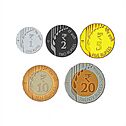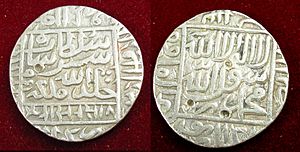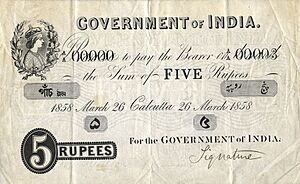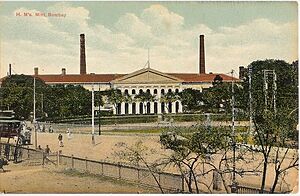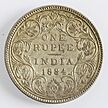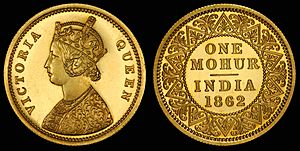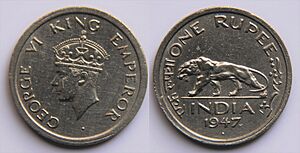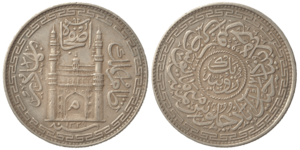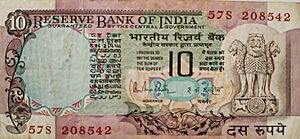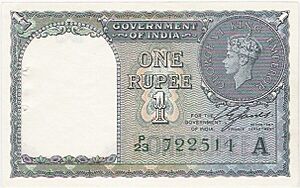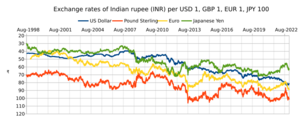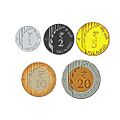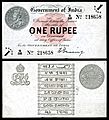Indian rupee facts for kids
Quick facts for kids Indian rupee |
|||||
|---|---|---|---|---|---|
|
|||||
| ISO 4217 Code | INR | ||||
| Official user(s) |
|
||||
| Unofficial user(s) | |||||
| Inflation | |||||
| Source | RBI – Annual Inflation Report | ||||
| Method | Consumer price index (India) | ||||
| Pegged by | [1₹=1.6 Nepalese Rupee] |
||||
| Subunit | |||||
| 1⁄100 | paisa | ||||
| Symbol | ₹ | ||||
| paisa | |||||
| Coins | |||||
| Freq. used | ₹1, ₹2, ₹5, ₹10, ₹20 | ||||
| Rarely used | 50 |
||||
| Banknotes | |||||
| Freq. used | ₹10, ₹20, ₹50, ₹100, ₹200, ₹500 | ||||
| Rarely used | ₹1, ₹2 , ₹5 | ||||
| Printer | Security Printing and Minting Corporation of India Limited | ||||
The Indian rupee (symbol: ₹; code: INR) is the official money used in India. The rupee is divided into 100 smaller units called paise. The Reserve Bank of India is in charge of printing and managing all the money in India. They follow rules set by the Reserve Bank of India Act, 1934.
Contents
What's in a Name? The Rupee's Story
The word rupee comes from an old Sanskrit word, rūpya. This word meant a piece of silver used as money. Ancient Indian texts from long ago, like the Arthashastra (written around 340–290 BCE), talk about silver coins called rūpyarūpa.
Other old coins were also mentioned. There were gold coins (suvarṇarūpa), copper coins (tāmrarūpa), and even lead coins (sīsarūpa). The rupee we know today comes from a silver coin called the rūpiya. This coin was first made by a ruler named Sher Shah Suri between 1540 and 1545. Later, the Mughal Empire kept using and standardizing it.
The History of Indian Money

India has a very old history of using coins. It was one of the first places in the world to make coins, around 600 BCE. This was around the same time as China and Lydia.
The Arthashastra, an ancient book, describes different types of coins. It mentions silver coins (rūpyarūpa), gold coins (suvarṇarūpa), copper coins (tamrarūpa), and lead coins (sīsarūpa). The word rūpa means 'form' or 'shape'.
The Gupta Empire also made many silver coins. These coins were influenced by earlier rulers. They were called Rūpaka and weighed about 2.2678 grams.
From Old Coins to Paper Money
The silver rupiya coin, first made by Sher Shah Suri, continued to be used for a long time. It was used during the Mughal period, the Maratha Empire, and even during British India.
Paper money, or banknotes, started appearing much later. Some of the first paper rupees were issued by banks like the Bank of Hindustan (1770–1832).
The British Influence on Indian Currency
During the 1800s, India was ruled by the British East India Company. In 1835, they decided to use a single silver rupee coin as the main currency. This coin was used throughout British India.
After the Indian Rebellion of 1857, the British government took direct control of India. The silver rupee coin remained the currency. In the 1890s, India switched to a "gold exchange standard." This meant that while silver coins and paper money were used daily, their value was linked to gold for international trade.
A New Rupee Sign for India
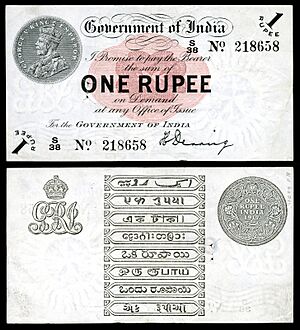
In 2010, India got a brand new symbol for its currency: ₹. A designer named D. Udaya Kumar created it. It combines the Indian letter "र" (ra) and the Latin letter "R".
The two parallel lines at the top of the symbol are special. They look like the flag of India and also represent an equality sign. This equality sign shows India's wish to reduce economic differences. The first coins with this new symbol came out on July 8, 2011. Before this, India used "₨" and "Re" as symbols.
The Digital Rupee
India is also exploring a Digital Rupee. This would be a digital version of the rupee, like digital cash. It would be controlled by the Reserve Bank of India.
How Indian Money is Made and Used
The Indian government has special laws about money. The "Coinage Act of 1835" allowed the British to make coins in the name of the British king. After India became independent, new laws were made to manage currency.
Indian Coins: Past and Present
Coins After Independence (1950-Present)
After India became independent in 1947, new coins were made. The first ones, in 1950, included 1 pice, half, one, and two annas, and quarter, half, and one-rupee coins.
Decimal Coins (1957-Present)

In 1957, India changed its money system to a decimal system. This means one rupee was divided into 100 naye paise. Before, it was divided into 16 annas. In 1964, the word naye (meaning "new") was dropped from the coins.
Over the years, different metals were used for coins. Aluminum, cupro-nickel, and stainless steel were common. Some older coins, like the 25-paise coin, were stopped because their metal value was more than their face value.
Today, the coins you'll commonly see are one, two, five, ten, and twenty rupees. The 50-paise coin is still legal, but you rarely see it.
| Value | Technical parameters | Description | Year of | |||||
|---|---|---|---|---|---|---|---|---|
| Diameter | Mass | Composition | Shape | Obverse | Reverse | First minting | Last minting | |
| 50 paise | 19 mm | 3.79 g | Ferritic stainless steel | Circular | Emblem of India | Value, the word "PAISE" in English and Hindi, floral motif and year of minting | 2011 | 2016 |
| 50 paise | 22 mm | 3.79 g | Ferritic stainless steel | Circular | Emblem of India | Value, hand in a fist | 2008 | |
| ₹1 | 25 mm | 4.85 g | Ferritic stainless steel | Circular | Emblem of India, value | Value, two stalks of wheat | 1992 | 2004 |
| ₹1 | 25 mm | 4.95 g | Ferritic stainless steel | Circular | Unity from diversity, cross dividing 4 dots | Value, Emblem of India, Year of minting | 2004 | 2007 |
| ₹1 | 25 mm | 4.85 g | Ferritic stainless steel | Circular | Emblem of India | Value, hand showing thumb (an expression in the Bharata Natyam Dance) | 2007 | 2011 |
| ₹1 | 22 mm | 3.79 g | Ferritic stainless steel | Circular | Emblem of India | Value, new rupee sign, floral motif and year of minting | 2011 | 2018 |
| ₹2 | 26 mm | 6 g | Cupro-Nickel | Eleven-sided | Emblem of India, Value | National integration | 1982 | 2004 |
| ₹2 | 26.75 mm | 5.8 g | Ferritic stainless steel | Circular | Unity from diversity, cross dividing 4 dots | Value, Emblem of India, Year of minting | 2005 | 2007 |
| ₹2 | 27 mm | 5.62 g | Ferritic stainless steel | Circular | Emblem of India, year of minting | Value, hand showing two fingers (Hasta Mudra – hand gesture from the dance Bharata Natyam) | 2007 | 2011 |
| ₹2 | 25 mm | 4.85 g | Ferritic stainless steel | Circular | Emblem of India | Value, new rupee sign, floral motif and year of minting | 2011 | 2018 |
| ₹2 | 23 mm | 4.07 g | Ferritic stainless steel | Circular | Emblem of India | Value, rupee sign, year of issue, grains depicting the agricultural dominance of the country | 2019 | |
| ₹5 | 23 mm | 9 g | Cupro-Nickel | Circular | Emblem of India | Value | 1992 | 2006 |
| ₹5 | 23 mm | 6 g | Ferritic stainless steel | Circular | Emblem of India | Value, wavy lines | 2007 | 2009 |
| ₹5 | 23 mm | 6 g | Brass | Circular | Emblem of India | Value, wavy lines | 2009 | 2011 |
| ₹5 | 23 mm | 6 g | Nickel-Brass | Circular | Emblem of India | Value, new rupee sign, floral motif and year of minting | 2011 | 2018 |
| ₹5 | 25 mm | 6.74 g | Nickel-Brass | Circular | Emblem of India | Value, rupee sign, year of issue, grains depicting the agricultural dominance of the country | 2019 | |
| ₹10 | 27 mm | 7.62 g | Bimetallic | Circular | Emblem of India and year of minting | Value with outward radiating pattern of 15 spokes | 2006 | 2010 |
| ₹10 | 27 mm | 7.62 g | Bimetallic | Circular | Emblem of India and year of minting | Value with outward radiating pattern of 10 spokes, new rupee sign | 2011 | 2018 |
| ₹10 | 27 mm | 7.74 g | Bimetallic | Circular | Emblem of India | Value, rupee sign, year of issue, grains depicting the agricultural dominance of the country | 2019 | |
| ₹20 | 27 mm | 8.54 g | Bimetallic | Dodecagonal | Emblem of India | Value, rupee sign, year of issue, grains depicting the agricultural dominance of the country | 2020 | |
Where Coins Are Made
Coins are made at four special places called India Government Mints. These are in Mumbai, Kolkata, Hyderabad, and Noida. The government is the only one allowed to make coins.
Special Commemorative Coins
Sometimes, the Indian government makes special coins to remember important people or events. These are called commemorative coins. For example, coins were made for the 150th birthday of Rabindranath Tagore and 1000 years of the Brihadeeswarar Temple.
Coins Before Independence
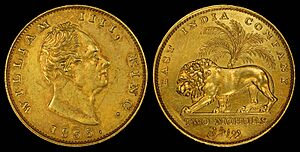
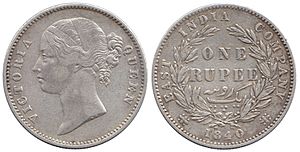



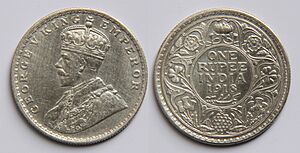
Before India became independent, the British East India Company made its own coins. Later, from 1862 to 1947, coins were made with the picture of the British Queen or King. These were called "regal issues."
Indian Banknotes
Banknotes After Independence
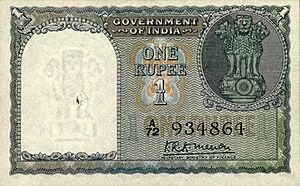
After independence, new banknotes were designed without the picture of George VI. The government kept printing the ₹1 note. The Reserve Bank of India (RBI) printed other notes, including very high values like ₹5,000 and ₹10,000 notes in 1949.
In the 1970s, ₹20 and ₹50 notes were introduced. However, notes higher than ₹100 were stopped in 1978. Later, in 1987, the ₹500 note was introduced, followed by the ₹1,000 note in 2000. The ₹1 and ₹2 notes were stopped in 1995.
The design of banknotes is approved by the Government of India. They are printed at special presses in places like Nashik and Mysore. The current series of banknotes is called the Mahatma Gandhi Series. These notes have a picture of Mahatma Gandhi on the front. This series started in 1996 and replaced older notes.
In 2016, the Indian government made a big change. They stopped using the old ₹500 and ₹1,000 banknotes. New ₹500 banknotes were issued, and a new ₹2,000 banknote was also introduced. These new notes have different designs and colors. For example, the new ₹500 note is stone grey and shows the Red Fort.
New banknotes for ₹10, ₹20, ₹50, ₹100, and ₹200 have also been released. These are part of the Mahatma Gandhi New Series.
Current Banknotes in Use
As of May 2023, you can find banknotes in denominations of ₹5, ₹10, ₹20, ₹50, and ₹100 from the older Mahatma Gandhi Series. From the newer Mahatma Gandhi New Series, you will see ₹10, ₹20, ₹50, ₹100, ₹200, and ₹500 notes. The ₹2,000 note was withdrawn from circulation in 2023.
| Image | Value | Dimensions | Main colour | Description | Date of issue | Circulation | |||
|---|---|---|---|---|---|---|---|---|---|
| Obverse | Reverse | Obverse | Reverse | Watermark | |||||
 |
 |
₹1 | 97 mm × 63 mm | Pink | New ₹1 coin | Sagar Samrat oil rig | National Emblem of India | 2020 | Limited |
 |
 |
₹5 | 117 mm × 63 mm | Green | Mahatma Gandhi | Tractor | Mahatma Gandhi and electrotype denomination |
2002 / 2009 | Limited |
| Image | Value | Dimensions | Main colour | Description | Date of issue | Circulation | |||
|---|---|---|---|---|---|---|---|---|---|
| Obverse | Reverse | Obverse | Reverse | Watermark | |||||
 |
 |
₹10 | 123 mm × 63 mm | Brown | Mahatma Gandhi | Konark Sun Temple | Mahatma Gandhi and electrotype denomination |
2017 | Wide |
 |
 |
₹20 | 129 mm × 63 mm | Greenish Yellow | Ellora Caves | 2019 | Wide | ||
 |
 |
₹50 | 135 mm × 66 mm | Cyan | Hampi with Chariot | 2017 | Wide | ||
 |
 |
₹100 | 142 mm × 66 mm | Lavender | Rani ki vav | 2018 | Wide | ||
 |
 |
₹200 | 146 mm × 66 mm | Bright Yellow | Sanchi Stupa | 2017 | Wide | ||
 |
 |
₹500 | 150 mm × 66 mm | Stone grey | Red Fort | 2016 | Wide | ||
 |
 |
₹2000 | 66 mm × 166 mm | Magenta | Mangalyaan | 2016 | Withdrawn from circulation | ||
| For table standards, see the banknote specification table. | |||||||||
Tiny Details: Micro Printing
The new Indian banknotes have tiny words printed in special places. For example, on Mahatma Gandhi's spectacles, you can find "भारत" (Bhārata), which is Hindi for India. On his collar, it says "भारत" and "INDIA". These tiny details are part of the security features.
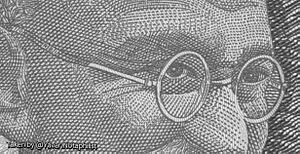
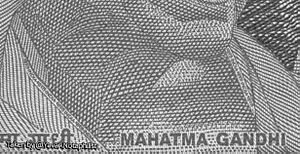
Banknotes Before Independence
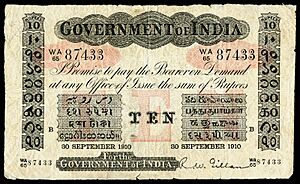
In 1861, the Government of India started issuing its first paper money. This included notes for ₹10, ₹5, and later much higher values. The Reserve Bank of India began printing banknotes in 1938.
How the Rupee is Traded (Convertibility)
The Indian rupee's value against other currencies changes based on the market. However, the Reserve Bank of India (RBI) sometimes steps in to keep the exchange rate stable. This is called a "managed float" system.
There are also rules about how much Indian rupees you can bring into or take out of the country. For example, you can only import or export up to ₹25,000 in cash. Also, certain high-value notes are not allowed in Nepal.
India has been slowly making it easier to exchange rupees for other currencies. This helps businesses trade and invest globally.
Important Dates for Rupee Convertibility
- 1991: India started to remove some rules on its currency. This made it easier to trade and send money.
- 1997: A plan was made to allow full convertibility by 2000, but it was paused due to a financial crisis in Asia.
- 2016: The government stopped using old ₹500 and ₹1,000 banknotes. This was done to fight illegal money and fake currency.
- 2023: The Reserve Bank of India announced that ₹2,000 notes would be taken out of circulation. This was because fewer of these notes were being used.
Rupee's Value Against Other Currencies
Historical Exchange Rates
For a long time, the Indian rupee's value was linked to silver. This caused problems when other major countries used gold as their standard. Later, the rupee's value was linked to the British pound and then the US dollar.
After India became independent, its exchange rate changed several times. In 1991, during an economic crisis, the rupee's value was lowered. Since then, it has mostly been a "floating exchange rate." This means its value changes based on supply and demand in the market.
| Currency | ISO code | 1947 | 1966 | 1995 | 1996 | 2000 | 2004 | 2006 | 2007 | 2008 | 2009 | 2010 | 2013 | 2014 | 2015 | 2016 | 2017 | 2018 | 2019 | 2020 | 2021 | 2022 | 2023 |
|---|---|---|---|---|---|---|---|---|---|---|---|---|---|---|---|---|---|---|---|---|---|---|---|
| Australian dollar | AUD | – | 5.33 | – | 27.69 | 26.07 | 33.28 | 34.02 | 34.60 | 36.81 | 38.22 | 42.00 | 56.36 | 54.91 | 48.21 | 49.96 | 49.91 | 50.64 | 50.01 | 56.30 | |||
| Bahraini dinar | BHD | – | 13.35 | 91.75 | 91.24 | 117.78 | 120.39 | 120.40 | 109.59 | 115.65 | 128.60 | 121.60 | 155.95 | 164.55 | 170.6 | 178.3 | – | 169.77 | |||||
| Bangladeshi taka | BDT | – | – | 0.84 | 0.84 | 0.77 | 0.66 | 0.63 | 0.57 | 0.71 | 0.66 | 0.68 | 0.80 | 0.88 | 0.84 | 0.85 | – | 0.76 | |||||
| Canadian dollar | CAD | – | 5.90 | 23.63 | 26.00 | 30.28 | 34.91 | 41.09 | 42.92 | 44.59 | 52.17 | 44.39 | 56.88 | 49.53 | 47.94 | 52.32 | 50.21 | 51.38 | |||||
| Renminbi | CNY | – | – | – | – | – | – | – | – | 5.80 | – | – | – | 9.93 | 10.19 | 10.15 | – | 9.81 | |||||
| Emirate dirham | AED | – | – | – | – | – | – | – | – | – | – | – | – | – | 17.47 | 18.26 | 17.73 | 17.80 | |||||
| Euroa | EUR | – | – | 42.41 | 44.40 | 41.52 | 56.38 | 64.12 | 68.03 | 60.59 | 65.69 | – | – | 70.21 | 72.60 | 75.84 | 73.53 | 79.52 | |||||
| Israeli shekelb | ILS | 13.33 | 21.97 | 11.45 | 10.76 | 10.83 | – | – | – | – | – | – | – | 17.08 | 16.57 | 17.47 | – | 18.36 | |||||
| Japanese yenc | JPY | 6.6 | 2.08 | 32.66 | 32.96 | 41.79 | 41.87 | 38.93 | 35.00 | 42.27 | 51.73 | 52.23 | 60.07 | 57.79 | 53.01 | 62.36 | – | 56 | |||||
| Kuwaiti dinar | KWD | – | 17.80 | 115.5 | 114.5 | 144.9 | 153.3 | 155.5 | 144.6 | 161.7 | 167.7 | 159.2 | 206.5 | 214.3 | 213.1 | 222.4 | 211.43 | ||||||
| Malaysian ringgit | MYR | 1.55 | 2.07 | 12.97 | 14.11 | 11.84 | 11.91 | 12.36 | 11.98 | 13.02 | 13.72 | 14.22 | 18.59 | 18.65 | 16.47 | 16.37 | – | 15.72 | |||||
| Maldivian rufiyaa | MVR | 1.00 | 1.33 | 2.93 | 2.91 | – | – | – | – | – | – | – | 4.58 | 4.76 | 5.01 | 5.23 | – | 4.13 | |||||
| Pakistani rupee | PKR | 1.00 | 1.33 | 1.08 | 0.95 | 0.80 | 0.77 | 0.75 | 0.67 | 0.61 | 0.59 | 0.53 | 0.57 | 0.60 | 0.62 | 0.64 | – | 0.57 | 0.46 | 0.45 | |||
| Pound sterling | GBP | 13.33 | 17.76 | 51.14 | 55.38 | 68.11 | 83.06 | 80.63 | 76.38 | 71.33 | 83.63 | 70.63 | 91.08 | 100.51 | 98.11 | 92.00 | 83.87 | 90.37 | |||||
| Russian rubled | RUB | 6.60 | 15.00 | 7.56 | 6.69 | 1.57 | – | – | – | – | – | – | – | – | 1.05 | 0.99 | – | 1.10 | |||||
| Saudi riyal | SAR | – | 1.41 | – | – | – | – | – | – | – | – | – | – | – | 17.11 | 17.88 | – | 17.02 | |||||
| Singapore dollar / Brunei dollare | SGD / BND | 1.55 | 2.07 | 23.13 | 25.16 | 26.07 | 26.83 | 30.93 | 33.60 | 34.51 | 41.27 | 33.58 | 46.84 | 45.86 | 46.67 | 48.86 | – | 47.70 | |||||
| Sri Lankan rupee | LKR | – | 1.33 | 0.63 | 0.64 | 0.58 | – | – | – | – | – | – | 0.47 | 0.46 | 0.45 | 0.46 | – | 0.41 | 0.39 | 0.39 | |||
| Swiss franc | CHF | – | 1.46 | 27.48 | – | – | – | – | – | – | – | 43.95 | 66.95 | 66.71 | 66.70 | 68.40 | – | 65.48 | |||||
| US dollar | USD | 3.30 | 7.50 | 32.45 | 35.44 | 44.20 | 45.34 | 43.95 | 39.50 | 48.76 | 45.33 | 45.00 | 68.80 | 66.07 | 66.73 | 67.19 | 65.11 | 72.10 | |||||
| a Before 1 January 1999, the European Currency Unit (ECU) b Before 1980, the Israeli pound (ILP) c 100 Japanese yen d Before 1993, the Soviet ruble (SUR), in 1995 and 1996 – per 1000 rubles e Before 1967, the Malaya and British Borneo dollar |
|||||||||||||||||||||||
Current Exchange Rates
| Current INR exchange rates | |
|---|---|
| From Google Finance: | AUD CAD CHF EUR GBP HKD JPY USD AED JPY USD |
| From Yahoo! Finance: | AUD CAD CHF EUR GBP HKD JPY USD AED JPY USD |
| From XE.com: | AUD CAD CHF EUR GBP HKD JPY USD AED JPY USD |
| From OANDA: | AUD CAD CHF EUR GBP HKD JPY USD AED JPY USD |
| From fxtop.com: | AUD CAD CHF EUR GBP HKD JPY USD AED JPY USD |
The Rupee Around the World
The Indian rupee was once used in many other countries. This was because of India's history with the British Empire. Countries like Aden, Oman, Dubai, Kuwait, Bahrain, Qatar, Kenya, and Mauritius all used the Indian rupee at one point.
In 1959, India created a special currency called the Gulf rupee. This was for use outside India. It helped reduce gold smuggling. After India changed the rupee's value in 1966, many of these countries started using their own money.
Today, the Bhutanese ngultrum has the same value as the Indian rupee. Both currencies are accepted in Bhutan. The Nepalese rupee is also linked to the Indian rupee. Indian rupees are accepted in Bhutan and Nepal, but some high-value notes are not legal there.
Images for kids
-
Silver punch mark coin from the Maurya empire, called Rūpyarūpa, made around 3rd century BCE.
-
Silver coin of Skandagupta from the Gupta Empire, called Rūpaka, showing a peacock, from 455-467 CE.
-
The Rupiya coin, first made by Sher Shah Suri between 1540 and 1545.
-
A 5 Rupee note from the Government of India, issued in 1858.
-
A 1 rupee note from the Government of India, issued in 1917.
-
The first banknote of independent India, a one rupee note from 1949.
-
Micro printed words on Gandhi's spectacles.
-
Micro printed words on Gandhi's collar.
-
A 10 rupees note from the Government of India, issued in 1910.
See also
 In Spanish: Rupia india para niños
In Spanish: Rupia india para niños



